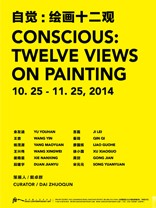TANG Contemporary Art is pleased to present a new group exhibition, Conscious: 12 Views on Paintingcurated by Dai Zhuoqun.
Opening on October 25th, the exhibition will present 12 artists’ individual thinking and practice of painting as well as the construction of their painting languages in order to trace the silently changing intrinsic lineages in local traditions and contemporary painting with the discussion of imagery. Dai also attempt to capture nearly thirty years of complex trends within Chinese contemporary painting; draw the progressive roadmap of gradual recovery of the essence of painting in the new era after the lifting of political ban through the multitude of individual painting practices that lie along this historical meridian; avoid the previous interpretive framework of historical determinism, return to the ever-changing, complex, diverse, and individual creativity and reveal the truth of painting with painting itself.
With the carding carried out by this exhibition, Dai Zhuoqun will first talk about imagery as a response to the relationship between current painting practices and the Chinese painting tradition. As a self-sufficient painting system that has lasted for one thousand years, ancient Chinese painting has no tradition of realism or abstraction. Instead, the spirit is written in form and the way is carried in objects, all of which comes from figuration and imagery and develops into the spaces of imagery and form. The essence of painting has never been shaken by outside elements. Secondly, Dai will discuss the unprecedented crisis that painting has faced for nearly one hundred years, focusing on the Eastern adoption of Western ideas and painting’s descent into utilitarianism. The intersecting discussion of these two issues is intended to break through artificial barriers between traditional and contemporary painting. Imagery is the point of incision for directly confronting the essence of painting.
Chinese painting takes the image as a basic starting point, but the focus is not the representation of nature. Instead, emphasis was placed on internal nature, not the exterior form. “Learn appearances from nature, and draw the interior from your heart.” For example, Chinese landscape paintings only depicted ideal landscapes, and not specific vistas. In explaining the difference between real and painted landscapes, Dong Qichang said, “Painting cannot equal nature for the marvels of mountains and water, but nature cannot equal painting for the marvels of brush and ink.” The painting and the painted subject are two independent yet interrelated entities. As philosopher Jean-Paul Sartre described in The Imaginary, “A description of the image is one thing, and induction about its nature another.”
Since the 1990s, with the emergence of the New Generation, Cynical Realism, and Political Pop Art, artists often left behind idealistic social passions, and began to focus on their own existences and spiritual states. During this time, painting still relied on the direct reflection of political and social reality. New Generation and Cynical Realism had not yet completed painting’s descent into utilitarianism, but they were the source for numerous derivative, vulgar images. During the same period, artists such as Yu Youhan, Wang Xingwei, and Wang Yin silently chose a decidedly different path. One after another, they began to engage with an introverted review of painting sources on a conscious, linguistic, and formal level. They began to experiment, focusing on the autonomy of painting languages and their own existences. After this happened, paintings about paintings and investigations of conceptions of painting became very important, and painting began to be used like language. Precisely because their paintings did not meet a utilitarian fate, their work was truly free and liberated, opening unlimited possibilities. The blending of international politics, economics, and culture have made Chinese art more diverse and open in the last decade, such that independent and individual creation is the norm.
Since 2000, the painting practice of the new generation of artists has gradually become freer and more diverse. In terms of the concept and language of painting, artists born in the 1970s and 1980s appear especially suited to this environment. Duan Jianyu, Xie Nanxing, Wang Guangle, Ji Lei, Qiu Xiaofei, Jia Aili, Qin Qi, Xu Xiaoguo, Gong Jian, Song Yuanyuan, and Liao Guohe represent a new generation of power in painting. Through the construction their own unique images and languages, they worked hard to bring the new era of Chinese painting back to its essence and establish its own subjectivity. These artists avoided the misfortunes of the Cultural Revolution and they grew up during the gradual collapse of the Cold War mentality. They are less likely to shoulder social and historical burdens, and they are very well-suited to our increasingly globalized world. The movement and sharing of knowledge and information makes them better able to understand the global art scene, both past and present, and they have reflected and responded to it, while staying rooted in the local context. They are actively enjoying the benefits of unprecedented economic and social development, and showing new creative tendencies.
In her essay “Contemporaneity as Points of Connection,” Zdenka Badovinac brilliantly explains contemporaneity as a cultural entity. “No single place can claim exclusive rights to emancipatory knowledge, which is important to the entire planet. It is true, however, that certain spaces have more potential to instrumentalize knowledge than others. Those that are in a better position in this regard also, therefore, contribute more to the positive or negative development of global society. Spaces with a weaker infrastructure, which might otherwise serve the ongoing structuring and distribution of local knowledge, are here in a disadvantaged position. The most these spaces can do is seek connections with other, similar conditions in the struggle for greater participation in the global exchange.” After a long transitional period, we can see the future direction of Chinese contemporary painting, which has emerged from a mixed, closed, and relatively weak position.









